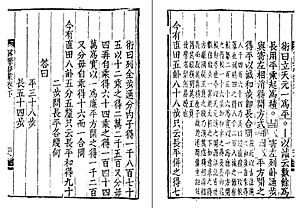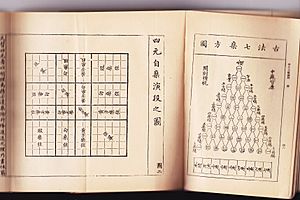Zhu Shijie facts for kids
Zhu Shijie (born around 1249, died around 1314) was a very important Chinese mathematician and writer. He lived during the Yuan dynasty in China. Zhu was born near what is now Beijing. He had a courtesy name, Hanqing, and a pen name, Songting.
Zhu Shijie created two major math books that we still have today. One is called Introduction to Computational Studies, and the other is Jade Mirror of the Four Unknowns. These books helped shape how people understood mathematics in China and even in Japan.
Contents
Introduction to Computational Studies
Zhu Shijie wrote Introduction to Computational Studies (also known as Suan hsüeh Ch'i-mong) in 1299. This book was like a basic math textbook. It had three parts, 20 chapters, and 259 math problems for students to solve.
The book taught people how to measure different shapes, like squares and circles, and also how to measure 3D objects, like cubes. This book was very important for the growth of Japanese mathematics.
For a while, this book was lost in China. But later, a mathematician named Luo Shilin found a copy that had been printed in Korea. He then had it published again in China, and since then, it has been printed many times.
Jade Mirror of the Four Unknowns
Zhu Shijie's second book, Jade Mirror of the Four Unknowns, was written in 1303. This is considered his most important work. With this book, Zhu made big steps forward in Chinese algebra, which is a type of math that uses letters and symbols to solve problems.
The book has 288 problems. The first few problems show his special way of using "four unknowns." These unknowns were called Heaven, Earth, Man, and Matter. Think of them like the 'x', 'y', 'z', and 'w' you might use in algebra today.
Zhu showed how to take a math problem described in words and turn it into a set of equations. He could use up to four unknowns in these equations. Then, he had a clever way to simplify these equations until he had just one equation with only one unknown.
He solved these complex equations using a method that was invented by another Chinese mathematician, Qin Jiushao, way back in 1247. This was more than 570 years before similar methods were developed in Europe! To do this, Zhu used something that looks just like what we now call Pascal's Triangle. He knew about this diagram long before the French mathematician Blaise Pascal was born.
For every one of the 288 problems in his book, Zhu gave the final equation and one of its answers.
Solving Complex Problems
Zhu Shijie also figured out how to find square roots and cube roots by solving certain types of equations. He also improved the understanding of number patterns called "series" and "progressions."
He even showed how to solve groups of linear equations. This is like solving several math puzzles at once. His methods were very advanced for his time. They were similar to modern math techniques that came much later.
The introduction to his book tells us that Zhu traveled all over China for 20 years. During this time, he taught mathematics to many students. His ideas from Jade Mirror of the Four Unknowns became a strong base for future math discoveries in China.
See also
In Spanish: Zhu Shijie para niños



